
Reverse-searing is a hot method for cooking steaks. Each bite has wall-to-wall pink perfection with a crispy seared crust, thus creating an incredible bite. The process is easily repeatable, and almost feels like cheating. Can you use any cut of steak for reverse-searing? Read along for our thoughts as we breakdown the pros and cons, and also set you on a path for steak success.
What is Reverse-Searing?
Almost every classic cookbook and restaurant teaches that when we cook a steak, we’re to sear it first over the grill or stovetop and transfer it to the oven to finish. Searing the steak supposedly locks in the juices, which is why that process is done first.

That method has been mythbusted, proving that searing simply adds texture and flavor, but has nothing to do with “locking in” anything. It also tends to create a more difficult scenario, which is attempting to time the oven-baking to a perfect temperature. No one likes to sit next to the stove, waiting!
Reverse-searing is exactly at is seems, the slow cooking method is used first and then the meat is finished with a high heat sear.
Using this process has some major advantages:
- Slowly bringing the steaks to temperature by smoking or baking allows the meat to cook evenly inside, therefore giving it a wall-to-wall pink color.
- Searing at the end provides a crispy crust, and minimal impact to the perfect internal temperature.
- There’s no need to rest the steaks after the sear because the initial slow cook ensures the juices won’t be flowing out when you slice.

Be sure to check out this guide on How to Reverse Sear a Steak for the details. This walks you through all of the steps, so that you can grill the perfect steak!
Can you Reverse-Sear Any Cut of Steak?
Yes, you absolutely can. Should you though?
This reverse-sear process is meant for one true purpose: A beautifully cooked interior of beef.
I mention beef, not just steaks, because the method is regularly used for large roasts. Think prime rib, beef tenderloins, eye of round, and many more cuts. Normally these very thick cuts of beef are difficult to cook properly, creating large grey bands around the outside with a pink center.

Now, let’s look at the extreme opposite, a thin-cut steak. Can you reverse-sear a thin steak? Yes, but it really isn’t worth the effort. Slowly bringing the steaks up to temperature doesn’t take much time with thinner cuts, not giving them much time to absorb the wood-fire flavor of smoking.
The other real disadvantage with reverse-searing thinner cuts is the potential to overcook them during the searing phase.

It takes a few minutes to fire off that crust on the outside, and because the steaks are so thin, there’s a higher chance of accidentally overcooking the inside while attempting to build the outside crust. Either you don’t get as nice of a crust to make sure the middle stays pink, or you overcook the inside by getting the crust you want.
If you’re going to cook thinner steaks, check out some of these recipes such as Steaks with Gorgonzola Mushroom Cream Sauce, Cajun Rubbed Steak (both using thin NY Strips), Grilled Steak Oscar, or the Spiced Habanero Flank Steak.
The Best Steaks to Reverse-Sear
Let’s get to the meat of it (hah) and discuss which steaks are the best to reverse-sear.
Thicker cuts have the biggest advantage when using the reverse-sear method. Since this is Over the Fire Cooking – not ‘In the Oven Cooking’ – we’re going to be indirectly cooking the meat over the coals which will provide an amazing smoke flavor!
Look for steaks that are a minimum of 1 ½-inch thick to 2 inches thick.
These steaks will take a little longer to cook, but that also means they will have plenty of time to pick up the delicious wood-fired flavor while slowly coming up to temperature.
Common Cuts of Steak to Reverse-Sear:

- Tomahawk Steaks. One of the most entertaining cuts of steak, and we make sure of that! Hang them using this method for Hanging Tomahawk Steaks to slowly cook before the sear.
- Thick Ribeyes. Find a thicker cut and you’ll never go back because these bad boys are freakin’ delicious. Try these out with Black Garlic Butter, Cowboy Butter, or even with a side of lobster for Grilled Surf and Turf.

- Picanha. Yes, this cut made popular from Argentina can also be reverse-seared. Try out the Smoked Picanha with Spicy Smoked Chimichurri for an incredible meal.
- T-Bone or Porterhouse Steaks. Since multiple cuts of steak are combined into one, this is typically a very difficult cut to cook evenly. The reverse-searing process really helps, try using the Espresso Rubbed T-Bone for a flavor bomb.

- Filet Mignon. These tender steaks are perfect for the process, creating an incredibly rich interior with a crispy crust on the outside. Try the Wood Plank Surf and Turf for a fun way to reverse-sear.
- Full Tenderloins. Makes sense right, since this is where filet mignons come from. Whether it’s a Parmesan Herb Crusted Beef Tenderloin or Herb Crusted Bison Tenderloin, both are great candidates for reverse searing.

- NY Strips. Earlier I called these out as thinner cuts, which they typically are, but if you’re able to get thick slices they work very well with the smoke & sear. One of our favorites to make are the Blue Cheese Crusted Steaks, topped with a flavorful layer of cheese.
Important Tip for Reverse Searing
The biggest key in all of this is closely monitoring your temperature because we don’t want to stop cooking it too early or too late. You’ll need an accurate temperature probe, preferably an instant-read temp probe. Let’s walk through the process of reverse-searing briefly.
Slowly Cook the Steaks
Slowly cooking your steaks is the first step, so build your fire and allow for a 2-zone setup. This means that the warm coals will be on one side of the grill, and the other half is the “cool zone”. Any grill that can use charcoal has this ability, so the set up process is pretty straightforward. Place the steaks on the cool side of the grill and then close the lid, allowing the steaks to smoke slowly to temp.

Take a look at this temperature guide, which is when you need to pull the steak out of the indirect heat in order to finish at your desired doneness:
Pull the steak off when it hits your ideal internal temperature:
- Rare = 120F
- Medium Rare = 130F
- Medium = 140F
- Well Done = 150F
Source: How to Reverse Sear a Steak
Searing Steaks to Finish
The time it will take to sear your steaks simply depends on how much surface you have to sear. Once the steaks have slowly cooked to temp, you can sear the steaks directly over the coals.

Be careful because you’re only looking to build a crust here. There’s no need to attempt to increase the temperature internally by much at all. Once you are happy with a crust on the outside, remove the steak and you’re done!
Longer Time, Better Steaks
Ultimately it takes longer to cook your thick steaks using reverse-sear, but you’ll have a consistent medium-rare with a crispy crust that will blow your mind. PLUS, the addition of wood-fired smoke flavor.

If you’re looking for a secret weapon to help your steaks taste even better, check out some of Derek’s Spiceology Rubs. There’s a wide variety of flavors and textures that will level up your game and make you the hero!
For more delicious recipes, check out Flavor X Fire or Food X Fire!
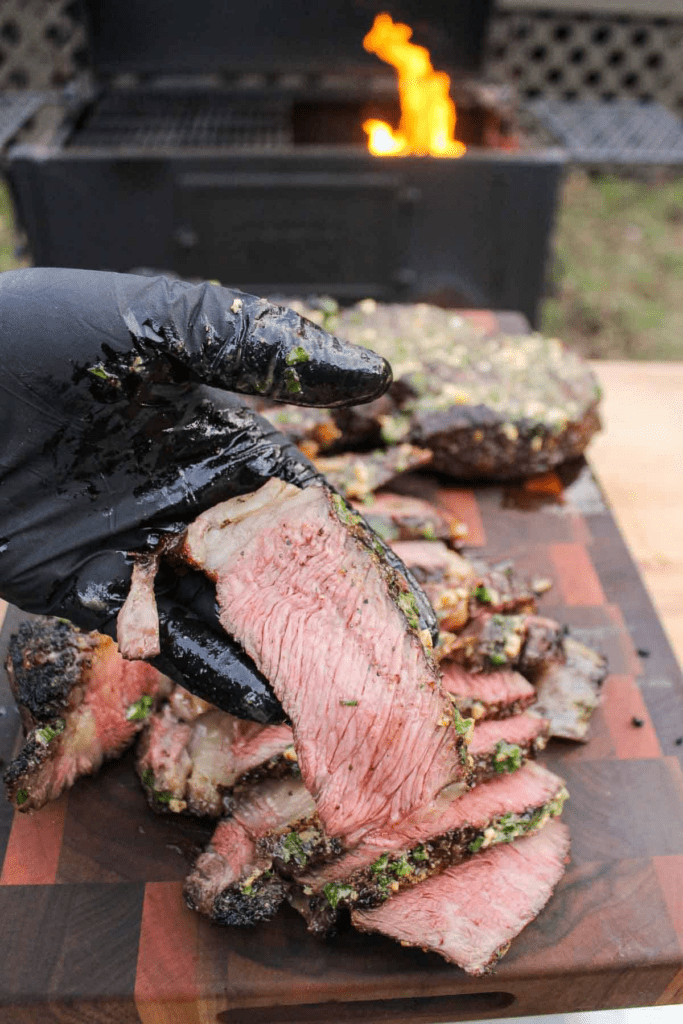
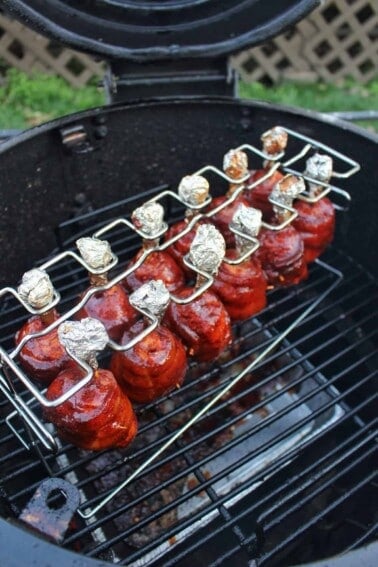
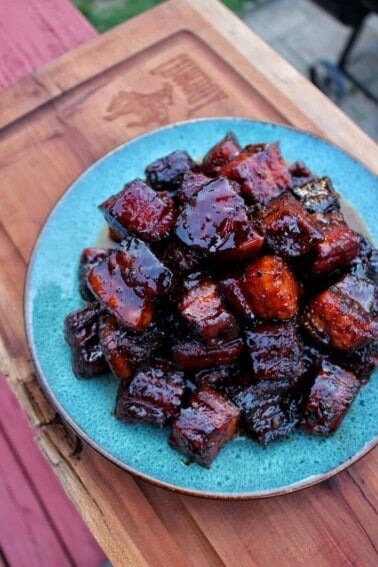
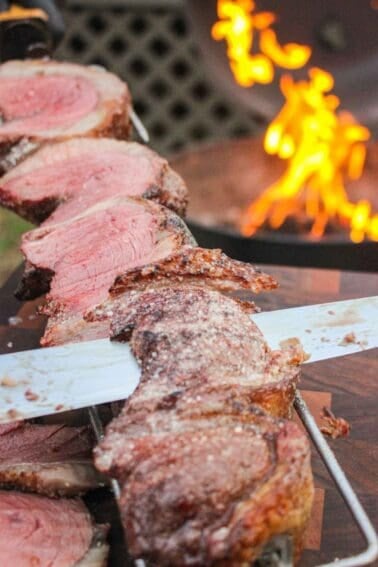
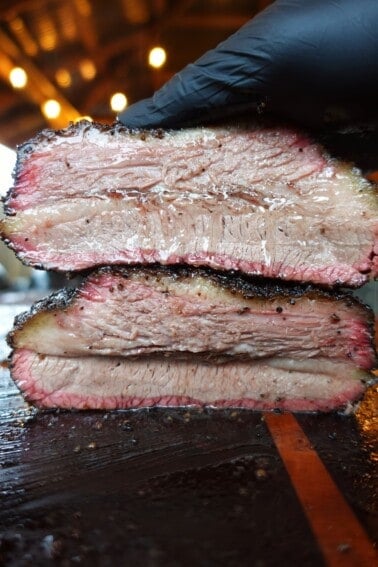








Hi there,
I love reading your emails although to be honest I am not a big fan of steak. But you do have other emails which are not just steak, like prawns.
Thanks so much for your kindness and my very best wishes to your recipes and business.
Kind regards
Mary
Thank you Mary! Happy grilling!